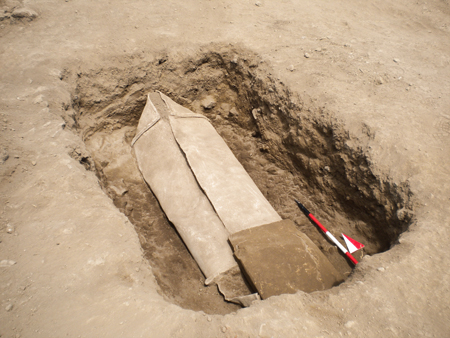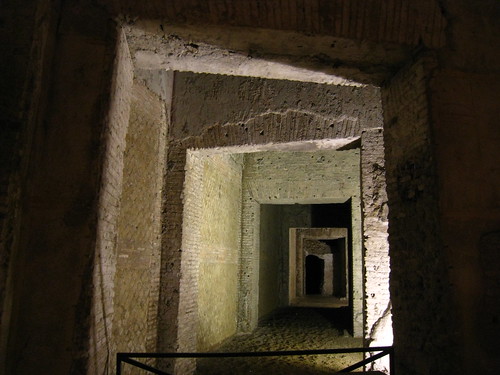A collection of Roman sculptures that was due to be sold at Bonhams auction house in London yesterday has been withdrawn amid concerns that the statues may have originally been illegally excavated. The concerns were raised by Cambridge researcher and archaeologist, Christos Tsirogiannis and Dr David Gill, reader in ancient history at Swansea University. Bonhams’s lot 137 a first or second century AD Roman marble figure of a youth was sold at Sotheby’s in 1986, as stated by Bonhams in the object’s collecting history. In his Looting Matters blog, Dr Gill compares a polaroid photo taken of one of the…
-
-
Two Roman altar stones have been found in the Scottish town of Musselburgh, six miles east of Edinburgh. They are thought to date back almost 2,000 years and were uncovered during renovation work at a cricket pavilion. The archaeological excavation took place before building work could start on Musselburgh Cricket Club‘s new pavilion. That could face a delay now that the Roman altar stones and, according to the cricket club, an Iron Age house were found on the first day of the dig. One of the altar stones has been identified as dating from the second century AD and is…
-
An underwater probe searching for evidence of vessels blown up by the Mafia to dispose of radioactive waste in the Mediterranean has found evidence of a shipwreck of a different kind containing several hundred Roman amphorae. The large clay ‘pots’ used to contain Roman foodstuffs (olive oil, wine, grain or fish sauce/garum) were spotted on the seabed off the coast of Campania in southern Italy by the company managing the underwater exploration. The Aberdeen-based company, Hallin Marine, which provides under-sea services to industry, was using remote operated vehicles (ROVs) as part of an Italian government-run investigation into the disappearance of…
-
So despite objections from campaign groups such as MediaWatch UK, it now looks as though British viewers will be able to watch the new TV series Spartacus: Blood and Sandafter all. Pay-TV channel Bravo, owned by Virgin Media, has bought the rights to the first two series and is planning to air the 13-part series this summer the dates are still to be confirmed. The show, which was broadcast by Starz Network in the US, has raised a few eyebrows with its graphic violence, scenes of orgies and ‘full-frontal’ nudity. So British viewers are certainly in for an eye-full this…
-
A page on social networking site Facebook has been gathering and publishing historical photos of the city of Rome. Roma Sparita (‘Vanished Rome’) has so far clocked up more than 64,500 fans since January (it’s growing rapidly) and has more than 7,200 ‘vintage’ photos online. The site is becoming far more than its four administrators ever expected. Most of the photos show Rome throughout the 20th century (up until 1990) and there are plenty of iconic scenes of people in the 50s and 60s riding Vespas or in vintage Fiats. Some of the photos also date back as far as…
-
It’s not often that stories of looting have a happy ending, but at the weekend a collection of illegally excavated silverware from the third century BC went on display for the first time back in their home-country of Italy. The treasure of Morgantina, as the collection is known, has been returned to Rome by New York’s Metropolitan Museum of Art, where it has been housed since 1982. How the pieces got to the Met is a dramatic and nebulous story of illegal antiquities smuggling and dodgy dealing. American antiquities dealer Robert Hecht sold the pieces to the Met in two…
-
Question: What does a gladiator wear on a night out? The answer, of course, is that he puts on his glad rags! Apologies for the terrible joke, but for those who want to know what a gladiator would really have worn, not on a night out in ancient Rome, but in combat in the arena, then an exhibition inside Rome’s Colosseum has opened to show us just that. The exhibition – Gladiatores – is displaying replica gladiatorial weapons, dress and armour made authentically according to nine years of historical research by Silvano Mattesini, a trained architect and expert in ancient…
-
Very unusual and very intriguing is how Nicola Terrenato from the University of Michigan describes a Roman-era lead coffin that has been uncovered in the ancient city of Gabii, 11 miles east of Rome. The professor of classical studies is the leader of an archaeological project to excavate the site. He added: It’s definitely the most unusual finding of the campaign so far. Who’s in the Lead Coffin? The lead sarcophagus, weighing about 450 kg, was found during last summer’s dig and is thought to date from the second to the fourth centuries AD. Researchers can’t be more exact about…
-
Sad news today for Italy: part of the complex archaeological structure surrounding Nero’s ‘Golden House’ in Rome his extravagant palace between 64-68 AD has collapsed following heavy rain. The Domus Aurea, as it is known, is one of the treasures of the ancient Roman world. Although it has been mainly closed to the public in recent years due to efforts to fend off encroaching damp and decay, it is a unique archaeological site and an important part of Italy’s heritage. The site is structurally complex and includes important buildings from the reigns of Nero and Trajan. When Nero committed suicide…
-
The Riace Bronzes, a pair of fifth-century BC statues of bearded warriors from the ancient Greek world, are undergoing restoration that experts hope will help them to answer some of the questions that have puzzled them ever since the statues were found off the coast of Calabria almost 40 years ago. To this day, archaeologists and historians are not sure of the identity of the two warriors. Some theories have speculated that they could represent two characters, Tydeus and Amphiaraus, from the ancient Greek play, Seven Against Thebes. A monument representing the play is known to have existed in Argos.…




